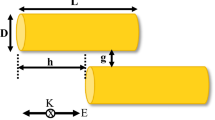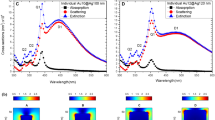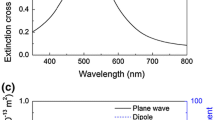Abstract
Breaking the morphological and compositional symmetries of metallic nanoparticle (NP) dimers provides a novel approach to modulate plasmon coupling between the NPs. In this study, we theoretically investigate the effect of symmetry breaking on the plasmonic coupling in morphologically asymmetric Au nanoring-nanodisk (NR-ND) dimer, compositionally heterogeneous Au-Ag nanoring dimer, and compositionally as well as morphologically asymmetric Au-Ag NR-ND heterodimers. It has been found that when the inner radii of symmetrical Au NR dimer is decreased, the scattering spectral intensity of coupled bonding mode and higher-order coupled bonding mode drastically decreases and increases, respectively. Besides, the effect of aspect ratio on the plasmon resonance modes is investigated. Furthermore, with fixed geometric parameters of one NR and by morphing the shape of the other NR into ND through inner radius, we show the generation and modification of a Fano resonance. As a result of introducing morphological and compositional asymmetry separately, single Fano-type spectral feature is observed in the scattering spectra. We demonstrate that the double Fano resonances can be easily achieved in compositionally and morphologically asymmetric heterodimer with double symmetry breaking. These dual modes are caused by the interference of dipolar bright mode (localized LSPR modes) of Ag NP with the quadrupole and hexapole modes (interband transitions) of the Au NP. Finally, at optimum asymmetric heterodimers, we discussed the effect of refractive index on the Fano-type resonance. These new and simple designs provide a novel insight to modulate optical response and the generation of higher-order Fano resonances, which have many potential applications such as in photonics and refractive index sensing.






Similar content being viewed by others
References
Garcia MA (2011) Surface plasmons in metallic nanoparticles: fundamentals and applications. J Phys D Appl Phys 44:283001
Olson J, Dominguez-Medina S, Hoggard A, Wang L-Y, Chang W-S, Link S (2015) Optical characterization of single plasmonic nanoparticles. Chem Soc Rev 44:40–57
Noguez C (2007) Surface plasmons on metal nanoparticles: the influence of shape and physical environment. J Phys Chem C 111:3806–3819
Verma S, Rao BT, Detty AP, Ganesan V, Phase DM, Rai SK, Bose A, Joshi SC, Kukreja LM (2015) Surface plasmon resonances of Ag-Au alloy nanoparticle films grown by sequential pulsed laser deposition at different compositions and temperatures. J Appl Phys 117:133105
Pathak NK, Ji A, Sharma RP (2014) Tunable properties of surface plasmon resonances: the influence of core–shell thickness and dielectric environment. Plasmonics 9:651–657
Špačková B, Wrobel P, Bocková M, Homola J (2016) Optical biosensors based on plasmonic nanostructures: a review. Proc IEEE 104:2380–2408
Luk'yanchuk B, Zheludev NI, Maier SA, Halas NJ, Nordlander P, Giessen H, Chong CT (2010) The Fano resonance in plasmonic nanostructures and metamaterials. Nat Mater 9:707–715
Barnes WL, Dereux A, Ebbesen TW (2003) Surface plasmon subwavelength optics. Nature 424:824–830
Gallinet B, Martin OJF (2011) Influence of electromagnetic interactions on the line shape of plasmonic Fano resonances. ACS Nano 5:8999–9008
Zhang KJ, Da B, Ding ZJ (2018) Effect of asymmetric morphology on coupling surface plasmon modes and generalized plasmon ruler. Ultramicroscopy 185:55–64
Halas NJ, Lal S, Chang WS, Link S, Nordlander P (2011) Plasmons in strongly coupled metallic nanostructures. Chem Rev 111:3913–3961
Sheikholeslami S, Jun Y-W, Jain PK, Alivisatos AP (2010) Coupling of optical resonances in a compositionally asymmetric plasmonic nanoparticle dimer. Nano Lett 10:2655–2660
Roopak S, Kumar Pathak N, Sharma R, Ji A, Pathak H et al (2016) Numerical simulation of extinction spectra of plasmonically coupled nanospheres using discrete dipole approximation: influence of compositional asymmetry. Plasmonics 11:1603–1612
Nguyen TK, Le TD, Dang PT, Le KQ (2017) Asymmetrically engineered metallic nanodisk clusters for plasmonic Fano resonance generation. J Opt Soc Am B 34:668–672
Zong X, Li L, Liu Y (2019) Dark plasmon in asymmetric nanoring arrays on conducting substrates and related applications. Opt Mater Express 9:870–877
Schubert I, Sigle W, van Aken PA, Trautmann C, Toimil-Molares ME (2015) STEM-EELS analysis of multipole surface plasmon modes in symmetry-broken AuAg nanowire dimers. Nanoscale 7:4935–4941
Li Z, Cakmakyapan S, Butun B, Daskalaki C, Tzortzakis S, Yang X, Ozbay E (2014) Fano resonances in THz metamaterials composed of continuous metallic wires and split ring resonators. Opt Express 22:26572–26584
Chen F, Alemu N, Johnston RL (2011) Collective plasmon modes in a compositionally asymmetric nanoparticle dimer. AIP Adv 1:032134
Brown LV, Sobhani H, Lassiter JB, Nordlander P, Halas NJ (2010) Heterodimers: plasmonic properties of mismatched nanoparticle pairs. ACS Nano 4:819–832
Slaughter LS, Wu Y, Willingham BA, Nordlander P, Link S (2010) Effects of symmetry breaking and conductive contact on the plasmon coupling in gold nanorod dimers. ACS Nano 4:4657–4666
Huang C-P, Yin X-G, Kong L-B, Zhu Y-Y (2010) Interactions of nanorod particles in the strong coupling regime. J Phys Chem C 114:21123–21131
Encina ER, Coronado EA (2010) On the far field optical properties of Ag−Au nanosphere pairs. J Phys Chem C 114:16278–16284
Abdulla HM, Thomas R, Swathi RS (2018) Overwhelming analogies between plasmon hybridization theory and molecular orbital theory revealed: the story of plasmonic heterodimers. J Phys Chem C 122:7382–7388
Göeken K, Subramaniam V, Gill R (2015) Enhancing spectral shifts of plasmon-coupled noble metal nanoparticles for sensing applications. Phys Chem Chem Phys 17:422–427
Hao F, Nordlander P, Sonnefraud Y, Dorpe PV, Maier SA (2009) Tunability of subradiant dipolar and Fano-type plasmon resonances in metallic ring/disk cavities: implications for nanoscale optical sensing. ACS Nano 3:643–652
Sonnefraud Y, Verellen N, Sobhani H, Vandenbosch GAE, Moshchalkov VV, van Dorpe P, Nordlander P, Maier SA (2010) Experimental realization of subradiant, superradiant, and Fano resonances in ring/disk plasmonic nanocavities. ACS Nano 4:1664–1670
Fang Z, Cai J, Yan Z, Nordlander P, Halas NJ, Zhu X (2011) Removing a wedge from a metallic nanodisk reveals a Fano resonance. Nano Lett 11:4475–4479
Khan AD, Miano G (2014) Investigation of plasmonic resonances in mismatched gold nanocone dimers. Plasmonics 9:35–45
Wu D, Jiang S, Cheng Y, Liu X (2012) Fano-like resonance in symmetry-broken gold nanotube dimer. Opt Express 20:26559–26567
Qiu J, Xie M, Lyu Z, Gilroy KD, Liu H, Xia Y (2019) General approach to the synthesis of heterodimers of metal nanoparticles through site-selected protection and growth. Nano Lett 19:6703–6708
Bigelow NW, Vaschillo A, Camden JP, Masiello DJ (2013) Signatures of Fano interferences in the electron energy loss spectroscopy and cathodoluminescence of symmetry-broken nanorod dimers. ACS Nano 7:4511–4519
Tsai CY, Lin JW, Wu CY, Lin PT, Lu TW, Lee PT (2012) Plasmonic coupling in gold nanoring dimers: observation of coupled bonding mode. Nano Lett 12:1648–1654
Forcherio GT, Blake P, DeJarnette D, Roper DK (2014) Nanoring structure, spacing, and local dielectric sensitivity for plasmonic resonances in Fano resonant square lattices. Opt Express 22:17791–17803
Koya AN, Ji B, Hao Z, Lin J (2016) Controlling optical field enhancement of a nanoring dimer for plasmon-based applications. J Opt 18:055007
Devaraj V, Choi J, Kim C-S, Oh J-W, Hwang Y-H (2018) Numerical analysis of nanogap effects in metallic nano-disk and nano-sphere dimers: high near-field enhancement with large gap sizes. J Korean Phys Soc 72:599–603
Jain PK, El-Sayed MA (2010) Plasmonic coupling in noble metal nanostructures. Chem Phys Lett 487:153–164
Bordley JA, Hooshmand N, El-Sayed MA (2015) The coupling between gold or silver nanocubes in their homo-dimers: a new coupling mechanism at short separation distances. Nano Lett 15:3391–3397
Hooshmand N, Mousavi HS, Panikkanvalappil SR, Adibi A, El-Sayed MA (2017) High-sensitivity molecular sensing using plasmonic nanocube chains in classical and quantum coupling regimes. Nano Today 17:14–22
Le KQ, Alù A, Bai J (2015) Multiple Fano interferences in a plasmonic metamolecule consisting of asymmetric metallic nanodimers. J Appl Phys 117:023118
Lassiter JB, Sobhani H, Knight MW, Mielczarek WS, Nordlander P, Halas NJ (2012) Designing and deconstructing the Fano lineshape in plasmonic nanoclusters. Nano Lett 12:1058–1062
Bachelier G, Russier-Antoine I, Benichou E, Jonin C, Del Fatti N et al (2008) Fano profiles induced by near-field coupling in heterogeneous dimers of gold and silver nanoparticles. Phys Rev Lett 101:197401
Lombardi A, Grzelczak MP, Pertreux E, Crut A, Maioli P, Pastoriza-Santos I, Liz-Marzán LM, Vallée F, del Fatti N (2016) Fano interference in the optical absorption of an individual gold–silver nanodimer. Nano Lett 16:6311–6316
Teo SL, Lin VK, Marty R, Large N, Llado EA, Arbouet A, Girard C, Aizpurua J, Tripathy S, Mlayah A (2010) Gold nanoring trimers: a versatile structure for infrared sensing. Opt Express 18:22271–22282
Koya AN, Lin J (2016) Bonding and charge transfer plasmons of conductively bridged nanoparticles: the effects of junction conductance and nanoparticle morphology. J Appl Phys 120:093105
Prodan E, Radloff C, Halas NJ, Nordlander P (2003) A hybridization model for the plasmon response of complex nanostructures. Science 302:419–422
Niu L, Zhang JB, Fu YH, Kulkarni S, Anchuk B (2011) Fano resonance in dual-disk ring plasmonic nanostructures. Opt Express 19:22974–22981
Zhang X, Liu F, Yan X, Liang L (2020) Multipolar Fano resonances in concentric semi-disk ring cavities. Optik 200:163416
Ding Y, Liao Z (2015) Asymmetric split nanorings for Fano induced plasmonic sensor in visible region. Phys B Condens Matter 464:51–56
He J, Fan C, Wang J, Ding P, Cai G, Cheng Y, Zhu S, Liang E (2013) A giant localized field enhancement and high sensitivity in an asymmetric ring by exhibiting Fano resonance. J Opt 15:025007
Wu X, Dou C, Xu W, Zhang G, Tian R, Liu H (2019) Multiple Fano resonances in nanorod and nanoring hybrid nanostructures. Chin Phys B 28:014204
Johnson PB, Christy RW (1972) Optical constants of the noble metals. Phys Rev B 6:4370–4379
Palk ED (1985) Handbook of optical constants of solids, vol 3. Academic Press, p 804
Cui J, Ji B, Song X, Lin J (2019) Efficient modulation of multipolar Fano resonances in asymmetric ring-disk/split-ring-disk nanostructure. Plasmonics 14:41–52
Schmidt FP, Ditlbacher H, Hofer F, Krenn JR, Hohenester U (2014) Morphing a plasmonic nanodisk into a nanotriangle. Nano Lett 14:4810–4815
Koya AN, Ji B, Hao Z, Lin J (2015) Resonance hybridization and near field properties of strongly coupled plasmonic ring dimer-rod nanosystem. J Appl Phys 118:113101
Kasani S, Zheng P, Wu N (2018) Tailoring optical properties of a large-area plasmonic gold nanoring array pattern. J Phys Chem C 122:13443–13449
Aizpurua J, Hanarp P, Sutherland DS, Käll M, Bryant GW, García de Abajo FJ (2003) Optical properties of gold nanorings. Phys Rev Lett 90:057401
Ye J, Van Dorpe P, Lagae L, Maes G, Borghs G (2009) Observation of plasmonic dipolar anti-bonding mode in silver nanoring structures. Nanotechnology 20:465203
Tsai C-Y, Chang K-H, Wu C-Y, Lee P-T (2013) The aspect ratio effect on plasmonic properties and biosensing of bonding mode in gold elliptical nanoring arrays. Opt Express 21:14090–14096
Wang W, Yu P, Zhong Z, Tong X, Liu T, Li Y, Ashalley E, Chen H, Wu J, Wang Z (2018) Size-dependent longitudinal plasmon resonance wavelength and extraordinary scattering properties of Au nanobipyramids. Nanotechnology 29:355402
Feng HY, Luo F, Meneses-Rodríguez D, Armelles G, Cebollada A (2015) From disk to ring: aspect ratio control of the magnetoplasmonic response in au/co/au nanostructures fabricated by hole-mask colloidal lithography. Appl Phys Lett 106:083105
Wang L, Liu Z, Yi X, Zhang Y, Li H, Li J, Wang G (2016) Analysis of symmetry breaking configurations in metal nanocavities: identification of resonances for generating high-order magnetic modes and multiple tunable magnetic-electric Fano resonances. J Appl Phys 119:173106
Li G, Hu H, Wu L (2019) Tailoring Fano lineshapes using plasmonic nanobars for highly sensitive sensing and directional emission. Phys Chem Chem Phys 21:252–259
Chahinez D, Reji T, Andreas R (2018) Modeling of the surface plasmon resonance tunability of silver/gold core–shell nanostructures. RSC Adv 8:19616–19626
Peña-Rodríguez O, Pal U, Campoy-Quiles M, Rodríguez-Fernández L, Garriga M, Alonso MI (2011) Enhanced Fano resonance in asymmetrical Au:Ag heterodimers. J Phys Chem C 115:6410–6414
Funding
This project was supported by National Natural Science Foundation of China (NSFC) (91850109, 61775021, 11474040); Education Department of Jilin Province (JJKH20181104KJ, JJKH20190555KJ); “111” Project of China (D17017); and Ministry of Education Key Laboratory for Cross-Scale Micro and Nano Manufacturing, Changchun University of Science and Technology.
Author information
Authors and Affiliations
Corresponding authors
Additional information
Publisher’s Note
Springer Nature remains neutral with regard to jurisdictional claims in published maps and institutional affiliations.
Rights and permissions
About this article
Cite this article
Dana, B.D., Koya, A.N., Song, X. et al. Effect of Symmetry Breaking on Plasmonic Coupling in Nanoring Dimers. Plasmonics 15, 1977–1988 (2020). https://doi.org/10.1007/s11468-020-01178-8
Received:
Accepted:
Published:
Issue Date:
DOI: https://doi.org/10.1007/s11468-020-01178-8




